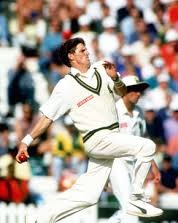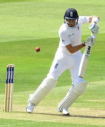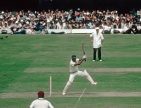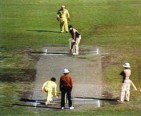Back to Back: Australia v South Africa 1993/94 – Part 1
Gareth Bland |
Having returned to the international fold from isolation in late 1991 with a series of one-day internationals in India, South Africa had made such progress by late 1993 that they were being touted as genuine challengers to the established order. That order, however, was already beginning to quake as the West Indies long, unchallenged supremacy was reaching a conclusion. In their stead Australia were heirs apparent; a team that had been crafted, and was being continually refined, under Bobby Simpson and Allan Border. From the doldrums of 1985 they were now on their way to conquering all in their wake. In September 1993 they returned home from yet another route of England, a state of affairs that was already beginning to take on an aura of biannual inevitability.
Australia’s opponents in the second half of the 1993/94 domestic summer were South Africa, after which the Australians themselves would return the favour by departing the Antipodes for a short three-Test series against the Proteas on their own patch. These back to back series would ,then, test the mettle of the two new powers in the game, thrown together in what was effectively a tantalising southern hemisphere heavyweight qualification bout. The Australians had fought their way here, inch by inch, beneficiaries of the tough love of coach Bobby Simpson and his on-field proxy Allan Border. The South Africans, on the other hand, had defied expectations; a team oven-ready for international cricket in spite of years of isolation and a testament to their powerful domestic competition.
South Africa’s first Test series in Australia for thirty years was eagerly anticipated. That excitement was severely tested, though, when a rain-delayed start to the new era in relations meant a heavily abbreviated opening three days of the first Test in Melbourne. The first day eventually began at 5pm, after which the Australian openers, Mark Taylor and Michael Slater, began proceedings in busy style. Michael Slater departed with his score on 32, and in a decision which proved the folly of sending in a nightwatchman too early, Shane Warne was leg before to Fanie de Villiers just one run later. From an overnight 58-2 Australia regrouped to build a first innings 342-7, the foundation of which was Mark Taylor’s gritty 170.
After persistent rain and bad light washed out the second day, and substantially curtailed the third, the Australian declaration meant that South Africa’s batsmen got to face their first deliveries in a Test match in Australia in three decades. Kepler Wessels’ team crawled their way to a steady 258-3, with the main contributors being Andrew Hudson with 64, Hansie Cronje’s 71 and Wessels himself with a captain’s 63. Following a long wait the jury was still out Down Under as to whether South Africa really had the star power to compete with the home team. It did not take long for everyone to realise that they most certainly had.
The two teams reconvened in the traditional New Year Test match venue of Sydney. Kepler Wessels won the toss and opted to bat in good conditions on one of the country’s best cricketing surfaces. If it was not Perth in terms of pace, the SCG offered evenness of bounce and the promise of turn later on. What South Africa received was, in fact, an early Sydney dividend in turn from a Shane Warne who mystified them to such an extent that they were dismissed in under 75 overs for just 169.
From a promising 91-1 with Peter Kirsten and Cronje well set, the tourists could only muster a further 78 as the innings nosedived after Cronje’s dismissal. Other than Kirsten, with 67, and Cronje, with 41, de Villiers alone of the remaining batsmen passed double figures, as Warne finished with 7-56 from 28 overs. It was in this series that the great leg-spinner began his dominance over Daryll Cullinan, a mastery over the right-hander so emphatic that Warne’s cruel jibes at the South African’s expense left him in a perpetual state of unease whenever he was in proximity to the spinner at the crease. Even to those used to, and well-practiced in, the art of sledging there was something particularly vindictive about Warne’s persecution of Cullinan. Warne spoke of his “authority” over the South African, while David Boon remembers:
“His mistakes were, of course, like the proverbial red rag to a bull. From then on, as Warnie cast his spell around him, Cullinan would be greeted with, ‘Is the shower already running, Daryll?
The Australians countered with 292, thanks to Taylor, with 92, Border, with 49, and Damien Martyn with 59. Donald and de Villiers were again penetrative, although veteran off-spinner Pat Symcox and Chris Matthews looked ineffectual on a true strip. Going in to bat for the second time South Africa reached 75 for the loss of Hudson when they again fell ensnared in the trap of the snake charmer Warne. Seventy-five for one rapidly became 110-5, with Cullinan again negated, as Jonty Rhodes strutted out to the crease. Following a partnership of 72 with ‘keeper Dave Richardson, Rhodes piloted the tail to an eventual 239. Warne was once again the star with 5-72, helping put his country within sight of an anticipated easy victory. Despite Rhodes’ heroics, an Australian target of 117 looked paltry, particularly in light of their mastery of the conditions in the preceding three days. On the fourth afternoon Slater and Taylor set about the run chase.
From pedestrian beginnings with the game easing Australia’s way, things suddenly changed when de Villiers dismissed David Boon, Tim May and Mark Taylor in the space of five runs. At the close Australia were 63-4 and, although shaken, few doubted their ability to surmount the final challenge of eking out the remaining 54 runs for victory on the fifth morning.
On the final morning 12,000 spectators turned up in anticipation of the final rites. What they actually witnessed was the reprise of an Australian nightmare from the previous decade with a final innings total to match. Before a run was added Donald clean bowled Allan Border with an absolute peach. From 75-8 a late McDermott flurry took the score to within spitting distance of victory. At 110 Martyn was dismissed and then, a run later, incredibly, McGrath was caught and bowled by de Villiers to end the Test match. Twelve and a half years after Headingley, Australia were dismissed for 111 again. Once more they had been set a supposedly easy, negotiable target in a game they had dominated and once more they had failed.
The innings was eerily reminiscent of the events in the Australians’ second innings at Leeds in 1981. Up in Yorkshire Border had been dismissed, clean bowled, by a corker from Chris Old leaving Australia 65-5. Here, Donald had “castled” him with the score at 63-5. At Headingley Geoff Lawson nudged Bob Willis to Taylor to make the score 75-8 and here, too, Warne departed, eighth man out, at 75. At Headingley ’81 a late rally from Bright and Lillee took the Australians from 75 to within sight of victory, when Lillee was dismissed with the score at 110. At Sydney ’94 Martyn and McDermott countered late in the piece to take the Australians close before Martyn was ninth out at 110. Substitute Willis’ emphatic removal of Ray Bright’s middle stump with Fanie de Villiers’ gallant catch off his own bowling to dismiss McGrath with the score at 111, and the coup de grace is complete. It was a thrilling, remarkable victory, one truly to render superlatives obsolete.
Having injured his thumb the previous afternoon Kepler Wessels had sat out the final day, where his deputy Hansie Cronje supervised events out in the middle. It is little wonder he was promoted to the top job on Wessels’ retirement. For the great fast bowler, Allan Donald, this one goes down unequivocally as his favourite Test match. Of the final day, he remarked:
“Of all the Tests I’ve played, that was the one with the most pressure. It was the most exciting day of Test cricket I have been involved in. Every ball was really felt. At that stage Kepler was still the captain, but the way Hansie handled the last day was a sign of how he would lead. He was very smart and very calm, and it showed when he took over the captaincy shortly after.”
Following three weeks of pyjama duty the players returned from the ODIs to contest the third and final Test of the series at Adelaide. Sydney did indeed turn out to be a hard act to follow, although in fairness Adelaide did have its charms. With the score 1-0 in the visitors’ favour, Border’s men needed the win to achieve parity.
Allan Border elected to bat on winning the toss, a decision vindicated when his team ran up a huge, and seemingly impregnable, 469-7 declared in their first innings. Star of the show was Steve Waugh with 169, although Border himself contributed 84 and Taylor and Slater 52 and 63 respectively. In reply South Africa once again looked well set as the openers began with a century stand. At the century mark Gary Kirsten fell to McDermott, after which Cronje was dismissed by Reiffel with the score at 103. Peter Kirsten joined Andrew Hudson in taking the score along to 173 before the opener was dismissed. Thereafter it was the military medium of Steve Waugh that, inexplicably, caused the South African collapse. From being well set 173-2 became 273 all out for South Africa. Australia then wrapped up their second innings in 40 overs, having declared on 124-6.
Chasing 321 for victory, history was not on the side of the tourists in Adelaide. Their eventual total of 129, 192 runs short of the required target, would have been even more emphatically feeble had it not been for Peter Kirsten’s 42 and the 30 from nightwatchman Fanie de Villiers. In the final Test, on the final day, Border’s Australia had come through and managed to share an exciting series.
If the Australians just shaded the series on points then South Africa showed enough combativeness and fighting spirit to have merited the draw. In truth, 1-1 was a fair result, bearing in mind South Africa’s prior isolation and the dominance that the Australians were then establishing within the international game. Allan Donald, then 27, was a formidable and experienced strike bowler, genuinely and intimidatingly fast, with skills honed both in South Africa and in the county championship. Fanie de Villiers offered spirited seam support and, in Sydney, enjoyed the match of his life. The combative Brian McMillan had joined the seam attack late in the series and gave his side an option that had earlier looked lacking.
If the batsmen looked troubled by the wiles of Shane Warne then, well, they were not alone in that. That said, Andrew Hudson and Gary Kirsten would prove to be a dogged and able opening pair, and Cronje’s tigerish batting and emerging leadership qualities also hinted at great things to come.
All in all, following a gap of three decades, this had been a memorable return to Australia for the South Africans. Things looked like they did indeed bode well for future series, even against the Australians. As it happened, the cricket watching world did not have long to wait for a return duel. No sooner had South Africa returned home than Australia arrived to contest the return series, and once more it was one of high drama and spirited cricket.





Leave a comment